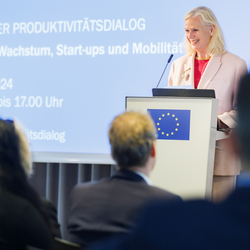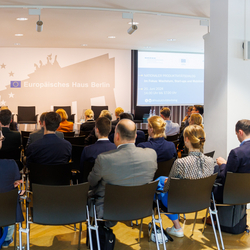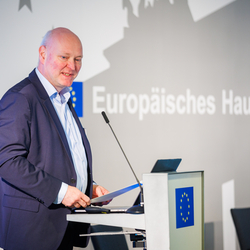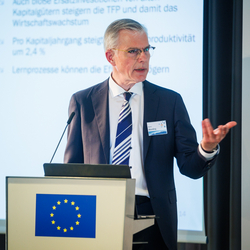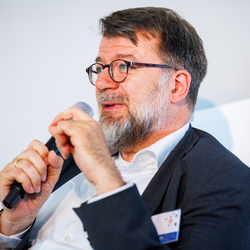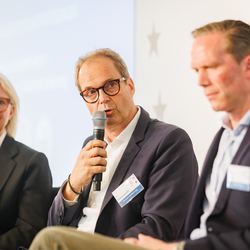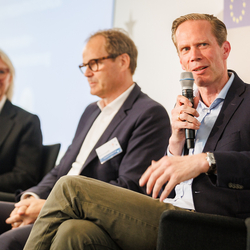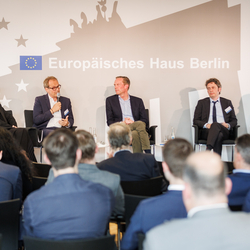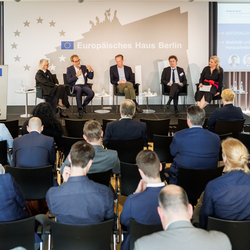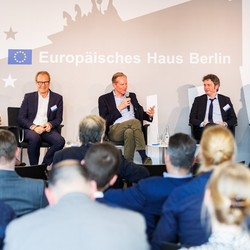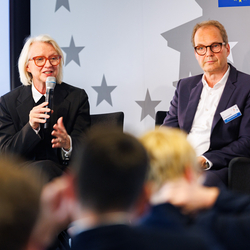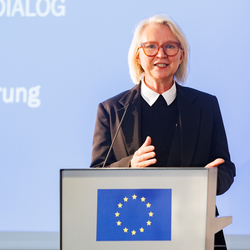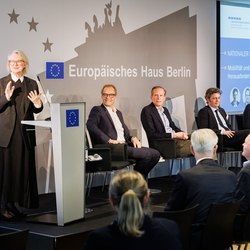Focus on innovations, start-ups and decarbonisation
National Productivity Dialogue 2024
A warm day in Berlin, plenty guests on site, exciting discussions with top-class participants: The fifth National Productivity Dialogue was a great success addressing key aspects for growth: innovation, start-ups and decarbonisation.
In his keynote speech, Martin Werding explained the German Council of Economic Experts' projection of potential growth and the relevant influencing factors:
Germany faces significant obstacles to growth in the coming decades. According to the projection, medium-term growth prospects are at a historic low. If current dynamics continue, production potential will only grow by an average of 0.4 per cent per year until after 2030, after which the growth rate will increase to 0.7 per cent per year.
The volume of labour will decrease due to demographic ageing. The number of people in employment is falling, particularly as a result of demographic ageing: Although most advanced economies are facing a similar demographic challenge, the age structure in Germany will change much faster than the OECD average over the next 15 years. In 2035, Germany will have one of the highest old-age dependency ratios of the OECD countries.
The exceptionally high net immigration of recent years is still offsetting the effect of ageing on the labour force. Although the projection of the GCEE includes a certain amount of net immigration and a higher labour force participation rate for the future, neither of these factors can compensate for the declining natural population trend. As a result, the contribution of the volume of labour to growth in production potential will remain negative until 2070.
Not only society is ageing: production facilities and the capital stock in Germany have also been ageing significantly since 1995 (measured via depreciation by the ratio of net capital stock to gross capital stock). An increasing proportion of investment in Germany is merely replacing old capital assets instead of increasing the capital stock. The contribution of capital investment to the growth of production potential has therefore fallen to an annual average of around 0.4 percentage points, compared with one per cent in the 1980s to the mid-1990s.
Business demographics in Germany are also ageing. Start-up rates in Germany are low compared to other European countries and have been declining until recently. The low start-up activity has likely been one reason for the low productivity growth in recent years.
So what needs to be done?
- Labour force: The labour force potential could be increased through higher migration and increased labour force participation of elderly people (keyword: later age of retirement). In addition, the labour force participation of secondary earner (mostly women) should be increased. A reform of the joint taxation of married spouses and improved childcare can contribute to this.
- Investments: "Investments in physical capital, such as automation, can help us and can compensate to some extent for a lower labour supply," said Martin Werding. "AI can be an essential part of accelerating innovation processes and freeing up labour that can be used elsewhere." New cross-sectional technologies such as AI can therefore strengthen growth in the long term.
- Start-up dynamics: Productivity can be improved by reallocating labour and capital helping to create more productive companies. In Germany, however, the start-up dynamic is rather low compared to other European countries. In particular, there is a lack of financial resources for the growth phase of start-ups. Venture capital is more readily available in the USA and Canada, for example. Public venture capital funds are particularly successful when co-financed with private investors.
Start-ups: the engine for growth opportunities in Germany?
AI is a huge opportunity to shape the transformation of German industry, explained Vanessa Cann (board member of the German AI Association). "We need to get to the point where companies scrutinise their business models."
Successful entrepreneurship is a question of role models, said Zoe Fabian (Deputy Chair of the German Startups Association). UnternehmerTUM (on the research campus of the Technical University of Munich), largest European start-up centre, should be a role model for other regions. At the same time, a European mindset is needed so that (young) companies and start-ups can survive in global competition. The still existing fragmentation of Europe into 27 national markets, some with national regulation, is the central challenge for companies in Europe. "Start-ups have to internationalise much more quickly here than in the USA, for example."
Germany is well positioned for early-stage financing, but there is a lack of funds for later-stage and growth financing, explains Klaus Müller (Head of Corporate Development and Communications at KfW Capital). "If such growth funds exist, they are too small. We have a simple task: make them bigger," he adds. Larger funds can invest larger tickets. Normally, a fund has an investment cap, which is usually 10 or 15 per cent. If a fund has 100 million in investment capital, it can only invest a maximum of 10 or 15 million in a single company. If the same fund is five times as large, it can invest correspondingly more, he continues. He also says, however, that this will not be possible with public funds alone; we need more private investors. Germany is lagging behind internationally in this respect.
Mobility and infrastructure – the challenge of decarbonisation
Freight transport plays an important role for Germany. This is due to the high proportion of industry, which means that preliminary products have to be transported to the production sites, and the strong focus on trade. Freight transport is responsible for eight per cent of Germany's greenhouse gas emissions, 98 per cent of which are attributable to road freight transport alone.
The key lever for decarbonising freight transport as a whole is the decarbonisation of road freight transport by switching to low-emission drive technologies, explained Monika Schnitzer at the start of the panel discussion. At the same time, freight transport is increasing in line with economic growth. She said that for a long time there has not been enough invested in infrastructure. Investments should not be made according to cash flow. It is crucial that it is invested reliably and in the long run, so that private sector capacities are also available.
Tim Scharwath (CEO DHL Global Forwarding, Freight) explained: "Not all lorries are the same, there are different applications." In local and distribution transport, it is possible to drive on battery power alone. In heavy goods transport, the range is not yet sufficient; we still have to wait for better batteries. We also need an appropriate charging infrastructure for this.
Infrastructure is one of several measures that cannot just be requested from the public sector. "As a manufacturer, we are also investing here," added Frederik Zohm (Executive Board Member for Research and Development at MAN Truck & Bus SE). However, on European level there is only the AFIR regulation, but no coordinating body for the development of the charging infrastructure. Germany is well positioned with the NOW GmbH and the National Centre for Charging Infrastructure.
The technological maturity of battery-powered lorries is significantly higher than for all other options."With batteries, we can fulfil all applications payload-neutrally." "But E-trucks cost 1.5 to 2 times as much as diesel-powered lorries." However, a favourable energy price could ease the burden on hauliers. If haulage companies were to generate their own electricity, there would be considerable potential for them, he continues. The energy efficiency of hydrogen and e-fuels is significantly lower than that of direct electrification.
Timur Gül (Chief Energy Technology Officer at the International Energy Agency) explained: "Globally, 18 per cent of all vehicle sales last year were electric – we are not there yet in freight transport." At the same time, 60 per cent of all battery electric vehicles sold in China were cheaper than combustion engines at the time of sale.
Programme National Productivity Dialogue 2024 (PDF in German)



